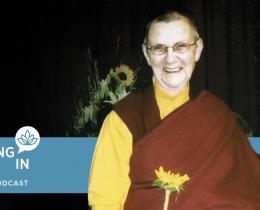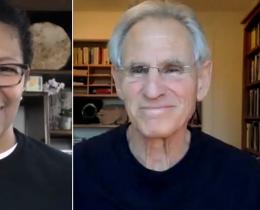In a society where doingness is more encouraged and awarded than beingness, it can be challenging to grasp that in “inaction” there is a great deal of “action” taking place. The slogan of the restless mind is: “Don’t just sit there; do something”; the slogan of the tranquil mind is: “Don’t just do something; sit there!”
Quite often, the first thing that happens when we give ourselves permission to sit and do nothing is that an avalanche of thoughts spreads mental graffiti across our mind, thoughts we’d rather avoid facing, which is one reason why we keep ourselves obsessively entertained and busy. We don’t stay in our seat long enough for such thoughts to recede into the background so that we can feel the pulse of our own soul. When unwelcome and embarrassing thoughts begin to rudely intrude, an egoic voice masquerading as “inspiration” causes us to jump up and fulfill, at last, our self-promise to exercise, to clean the closet, or handle some other “urgent” activity—anything to escape acknowledging our fears, discontent, scatteredness, forgetfulness, boredom, unworthiness, anxiety—you get the idea.
When you first sit to meditate, contemplate, or introspect, you bump into the seeming messiness of your life. See it as nothing more than egoic intrusion and simply allow it to pass through. Don’t bite the hook. Inwardly smile at the ego’s attempt and install yourself as the ruler of your consciousness and move on.
In our hyperactive society, it can be considered an act of spiritual chutzpah to turn off the cell phone, television, computer, and iPod to sit and seemingly do nothing. —Michael Bernard Beckwith
Developing the ability to sit and “be” without a mental tug-of-war with “doing” is acquired through the consistent practice of meditation. As Osho aptly put it, “Meditation techniques are doings, because you are advised to do something. But in a deeper way they are not, because if you succeed in them, the doing disappears.”
Although meditation was known and practiced in the West in the 1830s by the Transcendentalists, including Emerson, Thoreau, Whitman, Dickinson, and others, it didn't find a strong foothold in the U.S. in the 1960s. Still, many nonmeditators and cynics have the notion that it is self-indulgent. The truth is that meditation is not a selfish investment. On the contrary, when you begin to name the great mystics, idealists, activists, scientists, humanitarians, spiritual teachers, artists, inventors, entrepreneurs, and philosophers who have hugely impacted individuals, communities, countries, and our shared Earth, very often they credit a strong practice of interior prayer and/or meditation for inspiring their vision, mission, gifts, talents, and skills.
The medical world now recommends meditation as a legitimate contributor to healing. Dr. Andrew Newberg has published several books describing research results which indicate that meditation is associated with increased melatonin availability, which has anticarcinogenic and immune-system-enhancing effects. The neurochemistry of meditation has also been shown to increase the production of serotonin, an important neurotransmitter and neuropeptide that influences mood and behavior in many ways. Newberg’s studies on the neurochemical effects of meditation, coupled with established research on the neuroelectrical effects of meditation, indicate the profound and wide-ranging benefits and effectiveness that a regular practice of meditation offers for personal health.
It requires self-discipline to set aside time for meditation practice, to make it a daily priority in one’s life. In our hyperactive society, it can be considered an act of spiritual chutzpah to turn off the cell phone, television, computer, and iPod to sit and seemingly do nothing. Experience has convinced me that meditation is the most powerful spiritual technology for discovering our fundamental, enlightened state of being, which is why I define it as “paying undistractible attention to reality.” Contacting the reality of your soul-essence in meditation sensitizes your ability to realize your oneness with Source, to intuitively “see” your invisible soul qualities, access them more easily, and express them in the visible world.
When you turn the searchlight of the five senses and the mind within, you won’t find an accountant, actor, spiritual teacher, chef, wife, scientist, mother, father, friend, beloved—not even a spiritual seeker! Step beyond the thinking mind and you will liberate yourself from the accumulated identities under whose hypnotic spell you have been living. You are the Self, which has no name or label. Meditation blows back your hair and gives you a glimpse, perhaps for the very first time, of your Original Face, your true identity. From this vantage point you, too, will be one of those whose presence and open heart are blessings to all who cross your path.
Try This Classic Mindfulness Meditation Exercise
Although the Shamatha (mindfulness) meditation technique described below is simple, in the beginning it will seem like an effort and “doing” will be present. If you are new to meditation, even a 15-minute sitting is sufficient to begin with. If you have had some experience, then begin with 30 minutes. Advanced practitioners may continue with their current length of practice.
- Sit comfortably on a meditation cushion or a chair with your spine erect but without straining or overarching your back. If you are sitting on a floor meditation cushion, make sure your hips are elevated enough so that your back is not slumping and your knees rest flat on the cushion. Place your hands on your thighs, with your palms facing up or down.
- If you wish, close your eyes. If not, lower your gaze and place it just about four feet in front of you. If closing your eyes causes you to feel sleepy, then it’s best to practice with a lowered but open-eyed gaze. You need not focus on one spot, just rest your gaze. If sleep intrudes, reset your gaze a few feet more in front of you, or look straight ahead for a few seconds and then lower your gaze once again.
- After settling into your posture, place your attention on the breath, which will be your primary point of attention. Begin by slowly taking two or three deep inhalations, remaining aware of the air as it enters and exits your nostrils. Then breathe in a natural rhythm. Since you may not be accustomed to observing your breath, at first there may be a tendency to control the breath which may cause it to become irrecgular. Don’t worry about this, as you will soon return to your normal breathing pattern. Just be with the breath as it happens, one breath at a time.
- Distractions such as thoughts, emotions, aches, and fantasies will arise, which is perfectly natural. Sometimes you will spin out for a while before realizing that your attention is no longer on the breath. Don’t become annoyed with yourself (“Not again! When am I ever going to really meditate?”). Without frustration or judgment, mentally say “thinking,” and with lovingkindness to yourself bring your awareness back to the breath. Even though you may be a seasoned meditator, each time you take your seat tell yourself, “This is the first time I am meditating.” In this way you are not trying to recreate a meditation from the past or having a preconceived idea of what is “supposed” to happen.
- If at some point in your meditation a pleasurable melting into a sense of union with Source occurs, drop the technique and fully sink your awareness into this sweetness. When it subsides, return to your breath practice.
- Do something to signify the end of your sitting, whether it be reading an inspiring quote, a closing chant, a respectful bow, ringing a gong, or a prayer in the language of your heart expressing gratitude to you teacher and the teachings you are practicing.



